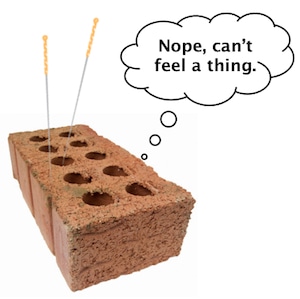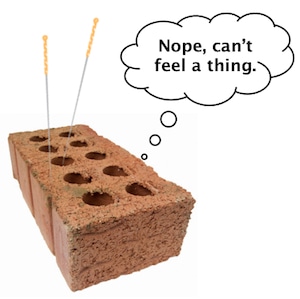Stuck record time for me again. A new paper in BMC Neuroscience has demonstrated that electroacupuncture or acupressure induces changes in activity in the sensory cortex. Using magnetoencephalography (MEG) researchers have demonstrated that these treatments are reflected in altered activity in the sensory cortex. They go on to conclude that alongside evidence from other studies of activation of various sub-cortical regions in response to acupuncture that ”these therapies show potential for affecting S1 processing and possible altering maladaptive neuroplasticity”. Or in other words the observation that acupuncture leads to brain activation might mean that it could be effective in treating chronic pain.

To me this is a bold interpretation of their data. What they have demonstrated is that stimulating sensory afferents leads to activation in the sensory cortex. A quick reflection on why we call it the “sensory cortex” should illustrate why this in itself is unsurprising. If they had not found altered activity what would they have concluded? That the participants were dead, that the sensory cortex is an inert brick (definitely worth a Nobel prize if replicated) or that the moniker “sensory cortex” is woefully misguided?
They also found that differing types of stimuli are reflected by different activation patterns and that the responses were attenuated as the 15 minute treatment went on. This is also not surprising since sensory perception, in part the result of this cortical activity, is a diverse feast of differing perceptual qualities. A prod and a prick do not feel identical and we might expect this to be reflected in the brain.
I have blogged on this problem of interpretation before. Brain activation in response to needling neither validates acupuncture nor provides a cogent mechanism for therapeutic action. That it activates sub-cortical networks involved “endogenous pain modulation” also does not distinguish acupuncture as a possibly effective active treatment since these networks are also implicated in the placebo response. Also, as I have oft repeated, given that our best evidence clearly indicates that it really doesn’t matter what you do with those needles, the sensory qualities of, or cortical responses to acupuncture seem unlikely candidates for a mechanism of action. It is not that the data in this study tells us nothing important. It adds to an existing body of data regarding how sensory input is cortically processed. But as a study of therapeutic mechanisms it attributes possible mechanisms to an effect that the best evidence tells us does not exist. I am reminded of this great line from the very naughty Daily Mash “it’s the equivalent of mapping the DNA of pixies or conducting a geological study of Narnia.”!
In my list of fantasy pointless facetious experiments I would like to perform brain imaging whilst having a research assistant bellow “ACUPUNCTURE!” or “PLACEBO!” at the unsuspecting participants. I predict that we would observe significant differences in specific brain regions that might just represent a therapeutic mechanism for bellowing the names of different therapies at people in pain. But perhaps that would just be silly.
About Neil
 As well as writing for Body in Mind, Neil O’Connell is a researcher in the Centre for Research in Rehabilitation, Brunel University, West London, UK. He divides his time between research and training new physiotherapists and previously worked extensively as a musculoskeletal physiotherapist. He also tweets! @NeilOConnell
As well as writing for Body in Mind, Neil O’Connell is a researcher in the Centre for Research in Rehabilitation, Brunel University, West London, UK. He divides his time between research and training new physiotherapists and previously worked extensively as a musculoskeletal physiotherapist. He also tweets! @NeilOConnell
He is currently fighting his way through a PhD investigating chronic low back pain and cortically directed treatment approaches. He is particularly interested in low back pain, pain generally and the rigorous testing of treatments. Link to Neil’s published research here. Downloadable PDFs here.
Reference

Witzel T, Napadow V, Kettner NW, Vangel MG, Hamalainen MS, & Dhond RP (2011). Differences in Cortical Response to Acupressure and Electroacupuncture Stimuli. BMC neuroscience, 12 (1) PMID: 21794103
Madsen MV, Gøtzsche PC, & Hróbjartsson A (2009). Acupuncture treatment for pain: systematic review of randomised clinical trials with acupuncture, placebo acupuncture, and no acupuncture groups. BMJ (Clinical research ed.), 338 PMID: 19174438



